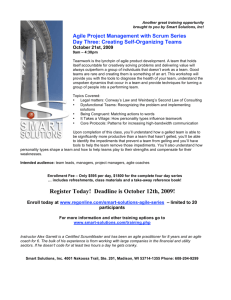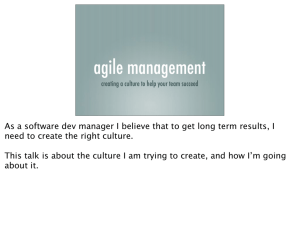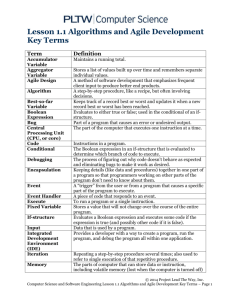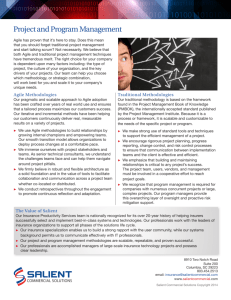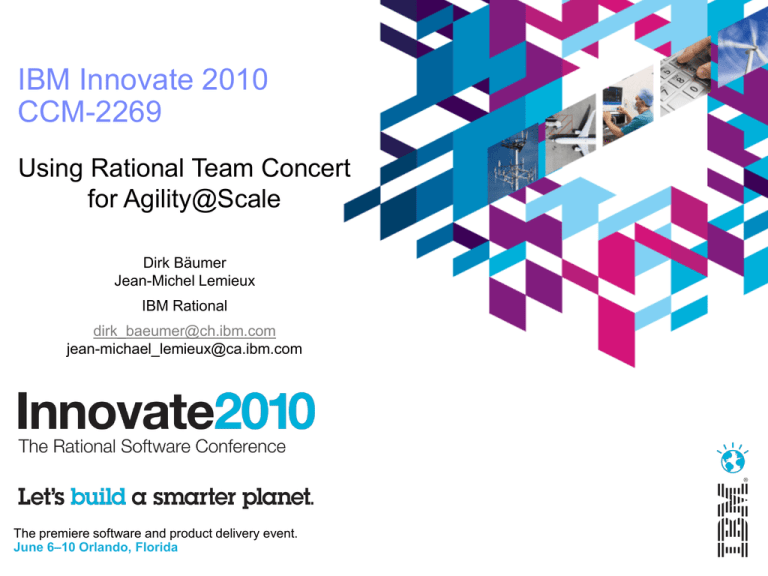
IBM Innovate 2010
CCM-2269
Using Rational Team Concert
for Agility@Scale
Dirk Bäumer
Jean-Michel Lemieux
IBM Rational
dirk_baeumer@ch.ibm.com
jean-michael_lemieux@ca.ibm.com
The premiere software and product delivery event.
June
Orlando, Florida
© 20096–10
IBM Corporation
IBM Rational Software Conference 2009
Agenda
Agile Planning Introduction
A Scrum Planning Episode
Scale my Project
How we use Agile Planning for
Developing RTC
RTC Q4.10 Outlook
Agile at Scale: Agile Planning
IBM Rational Software Conference 2009
DISCLAIMER
Information is confidential and must not be shared or
redistributed without permission from IBM
Plans are based on best information available and may
change in future
© Copyright IBM Corporation 2010. All rights reserved. The information contained in these
materials is confidential and is provided for informational purposes only, and is provided AS IS without
warranty of any kind, express or implied. IBM shall not be responsible for any damages arising out of
the use of, or otherwise related to, these materials. Nothing contained in these materials is intended
to, nor shall have the effect of, creating any warranties or representations from IBM or its suppliers or
licensors, or altering the terms and conditions of the applicable license agreement governing the use
of IBM software. References in these materials to IBM products, programs, or services do not imply
that they will be available in all countries in which IBM operates. Product release dates and/or
capabilities referenced in these materials may change at any time at IBM’s sole discretion based on
market opportunities or other factors, and are not intended to be a commitment to future product or
feature availability in any way. IBM, the IBM logo, Rational, the Rational logo, Telelogic, the Telelogic
logo, and other IBM products and services are trademarks of the International Business Machines
Corporation, in the United States, other countries or both. Other company, product, or service names
may be trademarks or service marks of others.
Agile at Scale: Agile Planning
IBM Rational Software Conference 2009
Agile Methods
There are several Agile Methods available, however from a bird’s eye view they
share a common set of tooling relevant properties:
Short development cycles (1 – 6 weeks)
Self organizing development teams
Joint planning meetings
Stand-up meetings
High personal responsibility of team members
Developers “manage” their work
Developers / Teams estimate
Progress tracking
Ongoing customer involvement
Retrospectives
Use of historical data to improve planning
Agile at Scale: Agile Planning
IBM Rational Software Conference 2009
The Planning Onion*
Strategy
Portfolio
Product
Release
Iteration
Daily
(*) Mike Cohn, Agile Estimating and Planning
Agile at Scale: Agile Planning
Agile team plans at the innermost
three levels
RTC offers support for all these
levels plus support for a product
wide backlog
IBM Rational Software Conference 2009
Agenda
Agile Planning Introduction
A Scrum Planning Episode
Scale my Project
How we use Agile Planning for
Developing RTC
RTC Q4.10 Outlook
Agile at Scale: Agile Planning
IBM Rational Software Conference 2009
Team Concert’s Agile Planning Support
Team Concert’s Agile Planning support has the following key
characteristics:
Process neutral (works with Scrum, OpenUp …), but assumes
short (1 – 6 weeks) development cycles
supports two level planning: release, iteration
supports monitoring releases, iterations
No separation between planning/implementing of features and bug fixing
Both planning and defect management share a common data model
They are supported in the same tool and are highly integrated
Plans are in fact a query for work items
Supports:
Top down planning (product owner, team lead, …) AND
Bottom Up (team members) AND
Plan consolidation (Sprint planning meetings, stand-ups, …)
Agile at Scale: Agile Planning
IBM Rational Software Conference 2009
Project Areas, Timelines, Iterations and Categories
defines Timelines
Project Setup
defines Categories
Work Item
Agile at Scale: Agile Planning
IBM Rational Software Conference 2009
Plan Definitions
Plans are owned by a team or
project and are associate with an
iteration
Plan contents is derived from this:
All work items which have a Filed Against
value set to a category owned by the plan’s
team or project and are planned for the
plan’s iteration.
They have a plan type, defining the
“onion” type of a plan. It is inferred
from the iteration, but can be
changed.
Agile at Scale: Agile Planning
IBM Rational Software Conference 2009
Plan and Execution items
Work items have two flavors:
Execution Items: work items which have
work assigned. In Scrum these are task,
defects, …
Plan Items: work items that are relevant
for the planning. In Scrum these are
Epics and Stories
RTC allows to customize which
work item types are plan items
and which types are execution
items.
Agile at Scale: Agile Planning
Plan
Items
Epic
Story
Execution
Items
Task
Story
Defect
IBM Rational Software Conference 2009
Plan Types
Product Planning:
Contains execution and planning work items of the product backlog
Release Planning:
contains execution and planning work items for
The plan’s iteration and all its child iterations
The plan’s team area or project area and all its child team areas
Support for teams of teams
Iteration Planning:
contains execution and planning work items for
The plan’s iteration
The plan’s team or project area
Daily planning:
My Work View
Agile at Scale: Agile Planning
IBM Rational Software Conference 2009
Background: Estimation and Sizing
Agile planning separates estimating the size from
estimating the effort
The size is often estimated in relative values. Scrum uses
Story Points
The effort is typically estimated in Ideal Hours/Days
Velocity measures a teams rate of progress
Completing 2 Stories of 5 story points in one iteration gives a velocity of 10
Good guess is to assume the same velocity for the next iteration
team velocity is what matters
Agile at Scale: Agile Planning
IBM Rational Software Conference 2009
Estimation and Sizing in RTC
Effort: Execution items are estimated in ideal hours.
Size: Plan items are estimated using a configurable numerical
sizing attribute
Scrum uses Story points. Other sizing attributes could be: lines of code, function
points, …
Agile at Scale: Agile Planning
IBM Rational Software Conference 2009
Velocity
RTC provides a velocity report
Agile at Scale: Agile Planning
IBM Rational Software Conference 2009
Effort Burn Down
Agile at Scale: Agile Planning
IBM Rational Software Conference 2009
Product Planning
Creates a high-level plan that contains stories not planned for
any release/iteration yet
a prioritized backlog of sized plan items (e.g. stories)
created by the product owner
Update with regular frequency
Agile at Scale: Agile Planning
IBM Rational Software Conference 2009
Background: Release Planning
Create a high-level plan that covers more than one iteration
a prioritized backlog of sized plan items
created by the product owner
has a release date
Define the iterations/iteration length
Updated with regular frequency
Agile at Scale: Agile Planning
IBM Rational Software Conference 2009
Release Planning in RTC
Configure the project areas time line
Create a plan of type release plan / product backlog
Take velocity reports or other historical data to find out how
many story points a team can handle per iteration.
Assign the plan items to the iterations, based on the backlog
order and the team’s velocity.
Agile at Scale: Agile Planning
IBM Rational Software Conference 2009
Background: Iteration Planning
Created during an iteration planning meeting
Decompose plan items into tasks
Estimate tasks and defects planned for an iteration
Team members sign-up for tasks during the iteration
Owner schedules his task
Agile at Scale: Agile Planning
IBM Rational Software Conference 2009
Iteration Planning in RTC
RTC provides different view modes
Breaking plan items into tasks
Tracking progress by owner during an iteration
…
Use Load Bars for capacity planning
Use Progress Bars to track progress
Agile at Scale: Agile Planning
IBM Rational Software Conference 2009
Work Load Bar
Problem: avoid overbooking team members.
Solution: Team Concert uses work load bars to show how much work is assigned
to a contributor, and whether he is overbooked or not. A work load bar shows:
horizontally: the ratio of remaining work time (usually for an iteration) and upcoming work.
vertically: the percentage of estimated open work items
So the less work items are estimated the less accurate the information is.
Encourages estimation
Upcoming work: 2 hours / Remaining work time: 96 hours not overbooked
100% of open work is estimated
Upcoming work: 136 hours / Remaining work time: 104 hours overbooked
75% of open work is estimated
Upcoming work: 35 hours / Remaining work time: 72 hours not overbooked
67% of open work is estimated, but since 33% of the work items aren’t
estimated there will be very likely not much work time left
Agile at Scale: Agile Planning
IBM Rational Software Conference 2009
Progress Bar
Problem: team lead needs to know how well the team is doing in terms of
progress.
Solution: Team Concert uses progress bars to reflect the progress of a team, a
contributor, or other grouping elements (tags, category, ...). A progress bar shows:
horizontally: the ratio of resolved and total work. If an iteration information and work assignment is
available a projection of this ratio onto the ratio of spent work time versus total work time is shown as
well.
vertically: the percentage of estimated open work items
So the less work items are estimated the less accurate the information is.
Resolved work: 9 hours / Total work: 11 hours
Spent work time: 17 / Total work time: 96
Resolved work: 4 hours / Total work: 140 hours
Spent work time: 53 / Total work time: 168 hours
Resolved work: 13 Hours / Total work: 186 Hours
No projection available
Agile at Scale: Agile Planning
9 - 11/96 * 17 == 2 hours ahead
4 - 140/168 * 53 == 40 hours behind
IBM Rational Software Conference 2009
Background: Ranked List and Planned Time
Ranked List
Sorts the work items in backlog order. Rearranging work items in this sort mode
will change its ranking on the backlog
Planned Time
Sorts the work items in the order in which the owner of the work item intends to
work on them. The owner defines this sequence typically in the My Work View.
Agile at Scale: Agile Planning
IBM Rational Software Conference 2009
Daily Planning
My Work View
Developer plans assigned work
Adjusts estimates
Agile at Scale: Agile Planning
IBM Rational Software Conference 2009
Daily Planning
Triage important defects onto the Iteration Plan
Team Central, Team Load and Iteration Plan
Run daily stand ups
Developer Taskboard to see what people are
working on
Planned Time mode to check overall schedule
Agile at Scale: Agile Planning
IBM Rational Software Conference 2009
Plan Risk Assessment
calculates
probability of task
fitting into the
schedule
More detailed
developer
estimation.. low,
nominal, high
Color codes high
risk tasks for
quick
identification and
action
Agile at Scale: Agile Planning
IBM Rational Software Conference 2009
Risk Assessment for my
planned work
Probability of completion is
shown in the My Work View
Agile at Scale: Agile Planning
IBM Rational Software Conference 2009
Agile at Scale: Agile Planning
28
IBM Rational Software Conference 2009
Agenda
Agile Planning Introduction
A Scrum Planning Episode
Scale my Project
How we use Agile Planning for
Developing RTC
RTC Q4.10 Outlook
Agile at Scale: Agile Planning
IBM Rational Software Conference 2009
Scaling Factors
Team size
Compliance requirement
1000’s of
developers
Under 10
developers
Critical,
audited
Low risk
Domain Complexity
Geographical
distribution
Co-located
Straight
-forward
Global
Enterprise discipline
Project
focus
Enterprise
focus
Agility
@
Scale
Organizational complexity
Flexible
Rigid
Agile at Scale: Agile Planning
Intricate,
emerging
Organization distribution
(outsourcing, partnerships)
Collaborative
Contractual
Technical complexity
Homogenous
Heterogeneous,
legacy
IBM Rational Software Conference 2009
Way of Working: Team Centric
Process
Streams
Members
follows
owns
delivers
has
Work Categories
Build
is responsible
Dashboard
Team
monitors
produces
defines
generates
Release/
Iteration Plan
Events
Teams are self-tuned but share a common rhythm
Agile at Scale: Agile Planning
IBM Rational Software Conference 2009
Changes
Scaling up: Teams of Teams
Jazz
Development
Team
Process Team
Repository Team
Sandboxes for each team with
“Integration points”:
Integration stream
Integration build
Plans
Release plan
Agile at Scale: Agile Planning
32
IBM Rational Software Conference 2009
Collaboration
Collaborate on software artifacts
Changes, defects, tasks, plans, builds
Approvals
Collaborate in context
Artifact relationships/links
Collaborations follow rules and patterns
Artifacts are in the center
Process
Agile at Scale: Agile Planning
IBM Rational Software Conference 2009
Transparency
Easy access to the projects artifacts from anywhere
Plans
Build results
Dashboards
Notification about changes in the project
Event feeds
Change histories
See where the project is
“Knowing what is going on without having to ask”
Transparency in process
Team structure, team roles
Agile at Scale: Agile Planning
IBM Rational Software Conference 2009
Agenda
Agile Planning Introduction
A Scrum Planning Episode
Scale my Project
How we use Agile Planning
for Developing RTC
RTC Q4.10 Outlook
Agile at Scale: Agile Planning
IBM Rational Software Conference 2009
Our Artifacts
Plans
Product Backlog
Release Plan
Iteration Plan
Items
Plan items, Stories, Tasks
Tracking
Build status
Adoptions
Defects
Enhancement
Retrospectives
Agile at Scale: Agile Planning
36
IBM Rational Software Conference 2009
Artifact Relationships
Release
found in
Iteration
Plan
promoted
planned
for
reported
against
Work Item
subscribes
approves
reviews
related
Build
included
implements
included
User
built from
Snapshot
Change Set
Artifacts
included
Stream
change flow
Workspace
Agile at Scale: Agile Planning
IBM Rational Software Conference 2009
Plan Input
Community
Stakeholders
PMC
Defect
Backlog
Team
Agile at Scale: Agile Planning
IBM Rational Software Conference 2009
Plan Input - continued
PMC
Requirements (release plan): traceability, …
Themes: improve performance, …
Concrete tasks: externalize strings
Community / Stakeholders
Requirements
Enhancements
Defect reports
Team
Architectural issues
Redesigns
Product ideas
Defect Backlog
Previous test passes
Self hosting
Agile at Scale: Agile Planning
IBM Rational Software Conference 2009
Our Plan Usage
Release Plan
Define themes
Define plan items
Plan Item Work item type
Tracking a Release
Effort less status tracking
Progress
Iteration Planning (Scrum of Scrum)
Tracking cross team efforts
Tracking burn down across teams
Retrospectives
Tracking Dependencies across teams
Agile at Scale: Agile Planning
IBM Rational Software Conference 2009
Our Plan Structure
Theme
5-10
Plan Item
Plan Item
Story
Story
Story
Task
Task
Agile at Scale: Agile Planning
Plan Item
40-50
IBM Rational Software Conference 2009
Our Release plan
Defines
themes and features
coarse grained
Themes define the high-level
customer value
Product wide backlog of Plan
Items/features
ranked
Plan items are broken down into
Stories and Tasks
Agile at Scale: Agile Planning
IBM Rational Software Conference 2009
Plan Item
Custom Attributes
Complexity
Development status:
on track
at risk
behind
Done criteria
Workflow
Proposed
Committed
Done
Agile at Scale: Agile Planning
IBM Rational Software Conference 2009
Backlog Grouped by Themes
Agile at Scale: Agile Planning
IBM Rational Software Conference 2009
Release Plan Status Tracking
Painless status tracking
Status updating
is tracked in a task with
approvals
Status updated at
end of each iteration
Agile at Scale: Agile Planning
IBM Rational Software Conference 2009
Planning and Tracking Iterations
Same rhythm across teams
Two level planning
Release plan defines
rhythm
themes and features
coarse grained
Iteration plan
per team/component
stories, tasks, enhancements, defects
fine grained
Agile at Scale: Agile Planning
IBM Rational Software Conference 2009
Definition of Done
Each Plan Item has Done Criteria
Agile at Scale: Agile Planning
IBM Rational Software Conference 2009
Planning/Execution: Feature Teams
A feature team is a cross product team owning a plan item
Agile at Scale: Agile Planning
IBM Rational Software Conference 2009
sign-off
sign-off
End of iteration
release demo
4 weeks
Agile at Scale: Agile Planning
stabilize
plan
develop
4 weeks
4 weeks
endgame
stabilize
fix - spit & polish
test
fix
test
…
M1
stabilize
plan
develop
M1a
plan
initial release plan
retrospective
decompression
warm-up
Retrospective
New&Noteworthy
develop
Our Timeline
sign-off
IBM Rational Software Conference 2009
Progress Tracking - Taskboards
See the work
currently in
progress
Drag and drop work
items to change their
state.
Agile at Scale: Agile Planning
IBM Rational Software Conference 2009
Plan Item
Custom Attributes
Complexity
Development status:
on track
at risk
behind
Done criteria
Workflow
Proposed
Committed
Done
Agile at Scale: Agile Planning
IBM Rational Software Conference 2009
Cross Team Dependencies/Adoptions
Adoptions:
Changes from lower layers that need to be adopted by other teams
Require approval from the project management team
“Lookahead planning”
New API delivered in M2 by team A
Adopted during M3 by team B, C, D
Expectations
Dependencies among teams
Tracked using work item links
Agile at Scale: Agile Planning
IBM Rational Software Conference 2009
Adoption Work Item Type
Attributes
Affected teams
Impact
Workflow
Proposed
Approved
Done
Agile at Scale: Agile Planning
IBM Rational Software Conference 2009
Adoption Items on the Dashboard
Agile at Scale: Agile Planning
IBM Rational Software Conference 2009
More support for Agility@Scale
RTC Build
personal builds
build snapshots
Buildforge Integration
Jazz SCM
isolation/integration using stream flow hierarchies => show our flow structure
private versions for code exploration
suspend resume for task isolation
Dashboards
for transparency
Agile at Scale: Agile Planning
IBM Rational Software Conference 2009
Agenda
Agile Planning Introduction
A Scrum Planning Episode
Scale my Project
How we use Agile Planning for
Developing RTC
RTC Q4.10 Outlook
Agile at Scale: Agile Planning
IBM Rational Software Conference 2009
RTC Q4.10 Outlook
Plan linking for Collaborative Lifecycle Management (CLM)
Plan Snapshots
Hybrid Planning
Disclaimer: © Copyright IBM Corporation 2010. All rights reserved. These materials are intended solely to outline our
general product direction and should not be relied on in making a purchasing decision. Information pertaining to new product
is for informational purposes only, is not a commitment, promise, or legal obligation to deliver any material, code or
functionality, and may not be incorporated into any contract. The development, release, and timing of any features or
functionality described for our products remains at our sole discretion. Nothing contained in these materials is intended to, nor
shall have the effect of, creating any warranties or representations from IBM or its suppliers or licensors, or altering the terms
and conditions of the applicable license agreement governing the use of IBM products. IBM, the IBM logo, Rational, the
Rational logo, Telelogic, the Telelogic logo, and other IBM products and services are trademarks of the International Business
Machines Corporation, in the United States, other countries or both. Other company, product, or service names may be
trademarks or service marks of others.
Agile at Scale: Agile Planning
IBM Rational Software Conference 2009
CLM Integration
Links between requirement
sets, development plans and
test plans
Linking between development
plans to create program /
project structures
Pickers and Hovers
Plans records are available as
REST resources
Agile at Scale: Agile Planning
IBM Rational Software Conference 2009
Plan Snapshots
Support to snapshot a plan containing the states of all work
items, references iterations, process areas and roll-up
information about effort, size and time spent.
Agile at Scale: Agile Planning
IBM Rational Software Conference 2009
Hybrid Planning
Most of the RTC customers are neither 100% agile nor 100% traditional
(even IBM isn’t )
Goal is to support projects that mix agile and traditional concepts.
The overall process is traditional the development execution happens
agile.
Need for an overview Gantt – which feature is delivered in which iteration
Visualization of the dependencies between features
The overall process is agile but the execution of a single iteration
happens traditional
Need for a traditional scheduler (schedule dependencies & constraints)
Need for traditional resource management
Agile at Scale: Agile Planning
IBM Rational Software Conference 2009
Learn more on Jazz.net
61
Agile at Scale: Agile Planning
IBM Rational Software Conference 2009
Agile at Scale: Agile Planning
62
IBM Rational Software Conference 2009
Disclaimer: © Copyright IBM Corporation 2010. All rights reserved. These materials are intended solely to outline our general product direction and should not be relied on in
making a purchasing decision. Information pertaining to new product is for informational purposes only, is not a commitment, promise, or legal obligation to deliver any material,
code or functionality, and may not be incorporated into any contract. The development, release, and timing of any features or functionality described for our products remains at
our sole discretion. Nothing contained in these materials is intended to, nor shall have the effect of, creating any warranties or representations from IBM or its suppliers or licensors,
or altering the terms and conditions of the applicable license agreement governing the use of IBM products. IBM, the IBM logo, Rational, the Rational logo, Telelogic, the Telelogic
logo, and other IBM products and services are trademarks of the International Business Machines Corporation, in the United States, other countries or both. Other company,
product, or service names may be trademarks or service marks of others.
Agile at Scale: Agile Planning
63
IBM Rational Software Conference 2009
References
Mike Cohn, Agile Estimating and Planning
Webcast: Using Rational Team Concert in a Globally
Distributed Team
https://jazz.net/blog/index.php/2009/01/06/webcast-using-rational-team-concertin-a-globally-distribute-team/
Agile at Scale: Agile Planning


